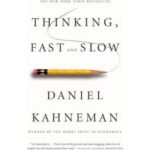LISTEN NOW
Outline: Thinking, Fast and Slow by Daniel Kahneman
Outline
Expand to Read ...
1. Introduction
- Purpose: Explores how humans make decisions, why we often make poor choices, and the cognitive processes underlying our actions.
- Main Areas:
- Cognitive systems: System 1 and System 2
- Cognitive biases and heuristics
- Prospect theory
- Happiness and the two selves
2. System 1 and System 2
2.1 System Characteristics
- System 1:
- Operates automatically, effortlessly, and involuntarily.
- Examples: Recognizing faces, detecting emotions, solving simple math problems.
- System 2:
- Engages in deliberate, effortful tasks requiring focus and concentration.
- Examples: Solving complex problems, making decisions, parking in tight spaces.
2.2 Interaction Between Systems
- System 1’s Role:
- Provides quick intuitions and suggestions.
- Cannot be deactivated and often operates beyond conscious control.
- System 2’s Role:
- Endorses or questions System 1’s outputs.
- Susceptible to cognitive strain, leading to reliance on System 1 and biases.
2.3 Implications
- Challenge: Balancing reliance on the two systems.
- Approach:
- Avoid overthinking minor decisions (trust System 1).
- Recognize when stakes are high and use System 2 more deliberately.
3. Cognitive Biases and Heuristics
3.1 Cognitive Shortcuts
- System 1 often substitutes hard questions with simpler, heuristic ones.
- Examples:
- Target Question: Is this stock a good investment?
- Heuristic Question: How do I feel about this company?
- Target Question: How satisfied am I with life?
- Heuristic Question: What’s my mood right now?
- Target Question: Is this stock a good investment?
3.2 Key Biases
- Confirmation Bias:
- Seeking information that confirms existing beliefs.
- “What You See Is All There Is”:
- Ignoring missing data or broader contexts.
- Planning Fallacy:
- Underestimating time and resources for projects.
- Sunk Cost Fallacy:
- Persisting with failed endeavors due to past investments.
- Reversion to the Mean:
- Attributing random performance changes to superficial causes.
- Anchoring:
- Allowing initial information to overly influence decisions.
- Representativeness:
- Over-relying on stereotypes, ignoring base rates or statistics.
- Availability Bias:
- Giving undue weight to vivid, emotionally charged memories.
- Narrative Fallacy:
- Creating coherent stories to explain random events.
4. Prospect Theory vs. Expected Utility Theory
4.1 Traditional Expected Utility Theory
- Assumes rational decision-making based on calculated utilities.
- Fails to explain:
- Risk aversion (choosing guaranteed outcomes over better expected values).
- Emotional weight of gains vs. losses.
4.2 Prospect Theory
- Key Insights:
- Evaluations depend on a reference point (e.g., expectations, status quo).
- Diminishing utility: Additional wealth feels less impactful with higher wealth.
- Loss aversion: Losses are more emotionally impactful than equivalent gains.
- Implications:
- Possibility Effect: Overvaluing low-probability events (e.g., lottery tickets).
- Certainty Effect: Overvaluing outcomes perceived as certain.
- Status Quo Bias: Overvaluing what we already have.
5. Framing Effects
- Decision-making is influenced by how options are presented.
- Example:
- A medical procedure framed as having a 90% survival rate feels better than one with a 10% mortality rate, though both are identical.
- Implication: Emotional reactions can override rational analysis.
6. Happiness and the Two Selves
6.1 Two Selves
- Experiencing Self:
- Feels pleasure and pain in the moment.
- Happiness measured as a sum of momentary experiences.
- Remembering Self:
- Reflects on past events, evaluates them, and shapes future decisions.
- Influenced by:
- Peak-End Rule: Intense moments and endings dominate memories.
- Duration Neglect: Length of experiences has little impact on memory.
6.2 Implications
- Decisions often prioritize the remembering self (e.g., choosing vacations for memorable experiences rather than momentary enjoyment).
- Kahneman advocates for focusing on the experiencing self to improve daily well-being.
7. Focusing Illusion
- People overestimate the importance of specific factors (e.g., weather, promotions) on overall happiness.
- Takeaway: “Nothing is as important as it seems while you are thinking about it.”
- Practical Advice:
- Focus on activities that consistently bring momentary pleasure.
- Avoid disproportionately dwelling on temporary setbacks.
8. Practical Applications
- Recognizing Biases:
- Identify situations where System 1 leads to errors.
- Use System 2 to reevaluate critical decisions.
- Improving Decisions:
- Question initial intuitions and consider broader contexts.
- Avoid framing traps and anchoring influences.
- Enhancing Happiness:
- Allocate time to activities that bring real-time joy.
- Reduce sources of recurring dissatisfaction, such as lengthy commutes.
9. Conclusion
- Kahneman’s research highlights the complexity of decision-making and the biases that distort our judgments.
- Understanding and managing the interplay between System 1 and System 2 can lead to better decisions, fewer mistakes, and greater overall happiness.

 Buy on Amazon
Buy on Amazon